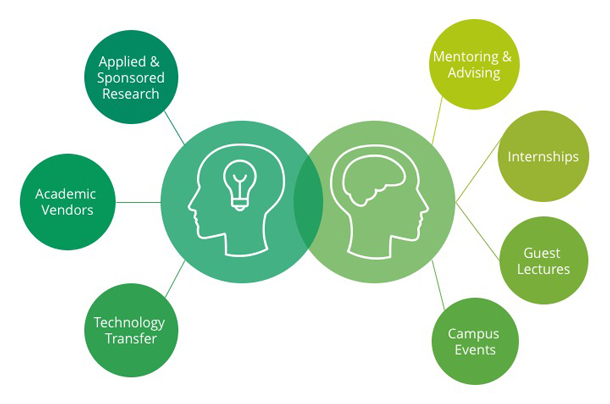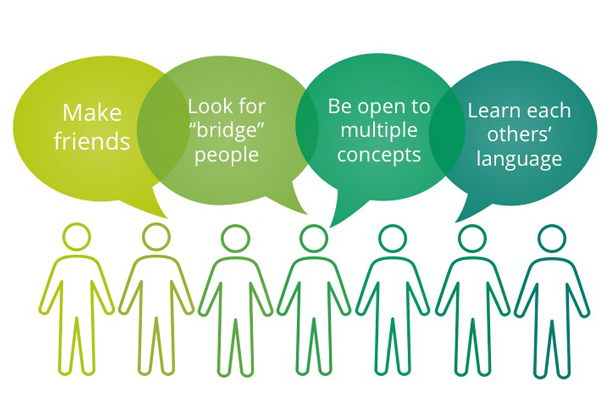This fall, a graduate of Michigan State University successfully begins a career as a user experience analyst for a large company. She has already interned there, so she knows the people and the work, and could not be more ready and excited. She majored in a UX program with professors who instilled critical thinking, writing, and design acumen. But further, she had the benefit of two UX professionals who came to campus to review her resume, portfolio, and presentations and offer informal advice on project work. With the help of all four co-authors (two of us professors and two of us UX professionals) working in tandem on- and off-campus, we helped to foster that talent for industry.

Developing a Talent Pipeline
Industry-academic collaborations can help develop a talent pipeline for many organizations and institutions working to staff specialized jobs and/or support training and professionalization opportunities missing from the workplace. Anecdotal hiring trends in UX show that many people are already working in both industry and academia, or making the leap from one to another. For example, practitioners teach classes for universities, and academics, such as HCI researchers, consult for industry. As job hopping is a rampant practice in the UX industry, we know that UX professionals are looking for opportunities that they might not find in one position in industry. Industry-academic collaborations may be able to help address this demand and provide professional development that industry alone cannot.
Additionally, degree programs in UX can contribute to the talent pool necessary for the growing the UX field, such as the Savannah College of Art and Design (SCAD) and Google’s collaboration to create an undergraduate Experience Design degree. Google has helped to develop the degree and offers regular extracurricular programs designed to inspire and to train UX designers to enter the Google workplace. These collaborations blend the teaching, professionalization, and research of both academy and industry partners to develop a new generation of UX professionals and scale in UX in new, exciting ways for the future.
“There is less and less support for industrial ‘big innovation’ that really will systematically change the world in fundamental ways, like Bell Labs’ invention of the transistor, fiber optics, etc. did. If it is going to happen at a scale that will make our world better, it is because industry and academia are partnering to encourage those areas of next generation research, and then transferring the human capital generated into industry.”
—Arnie Lund, professor of Practice at University of Washington Bothell, former manager/director at Amazon, GE Global Research, Microsoft, Sapient, US WEST Advanced Technologies, Ameritech, and Bell Labs
Promoting Innovation
Industry and academic collaborations can lead to next generation innovation. Working across industry and academia has, in the past, brought about important—even transformational—inventions and ideas. More recently, a model has emerged of a university housing a research institute that contracts with industry and employs their students to address grand challenges of society. One such institute is the UMTRI, the Transportation Research Institute at the University of Michigan, housing partnerships in multiple research areas, including human factors, HCI, and UX, to address transportation safety and infrastructure. In this way, talent is generated and innovative research is conducted simultaneously.
How We Collaborate on Building a Talent Pipeline
As a group, we collaborate within the Experience Architecture (XA) undergraduate program at Michigan State University. Faculty and students in the XA program directly work with an industry liaison—what we call the XA in Residence. While not a full-time on-site role, the XA in Residence is an embedded feature of the program, arranging monthly campus visits and phone and video chat support for students. As the industry link for students and faculty, the XA in Residence provides one-on-one career mentorship, access to a robust professional network, and an industry perspective in the classroom that is expressed in informal discussions, active learning activities, and workshops. Keith Instone was the first XA in Residence for the program, while Emily Bowman currently works in the position. The role also allows access to the next generation of practitioners and their emerging interests, skills, and perspectives on the field—information and relationships valuable for supporting talent recruitment.
Our collaboration began by focusing on learning activities. These activities often benefited both faculty, students, and the XA in Residence. For example, Emily participated in an improv session in Ben Lauren’s project management class and gave feedback on how students could improve their facilitation of awkward conversations at work (the point of the session). Emily found improv worked so well, she went to work and made a case for adding it to her employer’s training curriculum to facilitate creativity and ideation. Similarly, Keith participated in several “how to get a job” workshops for soon-to-graduate XA students. Topics focused on how to use LinkedIn effectively, how to eat lunch during a job interview, and how to create job materials. He learned while preparing for those workshops, and during them as well. He also met other people from the industry who were contributing to the workshop, which was useful for networking.
When Dawn Opel started as an assistant professor teaching in the XA program last year, she also began to work with Emily and Keith through activities like developing curriculum, co-teaching, and presenting together at conferences. For example, Keith and Dawn co-taught an Information Architecture class for a professor who was out of town for the week. They collaborated on teaching sessions that covered card sorting and labeling, learning from each other while also preparing students to do the work.
While fulfilling the role of an XA in Residence, Keith and Emily have engaged in several other activities in and out of the classroom. For example, Keith once spent a few hours sketching out the current program on a sheet of paper, showing how he saw the core courses in the major were related. One outcome was a new course on Information Architecture that had a stronger theory component to complement the existing project-based courses. Meanwhile, Emily has spent a great deal of time coaching students on Skype as they prepare to enter the workforce, even writing recommendations to people she knows at different organizations to hire XA students.
How Our Collaboration Is Evolving
More recently we’ve begun working on research projects on industry-academic collaborations as co-investigators to learn how to improve our own practices. We are also hoping to recruit more partners to help sustain an integrated approach to user experience education. We are scaling our collaboration into research that provides a win-win scenario for the four of us. By win-win, we mean that each of us benefits in ways that help further our careers and professional development, while also addressing one of our core goals as partners: to help contribute a well-prepared UX talent pipeline.
Toward this effort, our first project has been to collect various examples of industry-academic collaborations happening in the UX world. For this article, we narrowed down what we’ve learned to two areas: education and research. These interviews were conducted over the course of about a month between May and June 2017. We interviewed both industry practitioners and academics who have participated in collaborations.
Examples of Collaborations from Practitioners and Academics
Practitioners told us about their collaboration with academic units to support education initiatives, explaining that faculty benefit by the additional support and complementary skills of industry professionals. We also learned that motivations for companies are often to get a head start on talent development (helping universities teach what they need) and talent attraction (knowing the best candidates before they start looking for jobs). These collaborations can be quite informal, triggered just by a faculty member and practitioner who agree to try something out for a semester. A lot of universities have “industry boards” and invite practitioners to serve on them, forging a more formal and longer term commitment. As well, some companies and universities have built up long-term relationships around an internship program. Some other common examples of educational activities discussed in interviews were:
- Practitioners mentoring students
- Corporate “clients” for class projects
- Practitioners guest lecturing a class or teaching an entire course
- Professional associations/meet-ups partnering with student groups on events
- Student internships at companies
- Practitioners serving on dissertation and curriculum committees
For the last bullet, we’ve seen first-hand practitioners serving on Master’s thesis committees. For example, at MSU, we have a usability and accessibility lab and a director, Sarah Swierenga, who can serve on dissertation and thesis committees. While not a tenure stream faculty member, Sarah collaborates with research faculty on supporting student research.
Interviewees explained that the value proposition for the second area that focused on research was to achieve “innovation,” encouraging university researchers to find an application in industry (showing that the university has an impact) and complementing company research and development efforts (helping develop new products and services). We also learned that curiosity and professional development could be the main drivers for a collaborative project. Some collaborations mix “student experience” and “research” goals, such as serving on advisory boards and corporate sponsorship of “student research” projects. Some examples we discovered were:
- Practitioners who consult on faculty-applied research projects
- Companies hire a “vendor” from academia (often based on their research expertise)
- Corporate-sponsored research projects, undirected and targeted
- Traditional “technology transfer” between academia and industry

Advice for Practitioners
From the practitioner perspective, three of the keys to successful collaborations with academia were explained as the following:
- Proactively reaching out to academics and academic units is usually the best way to get things going instead of waiting for them to reach out to you.
- Make sure you get personal satisfaction from the project, and in general, get a sense of professional career growth through participating.
- Collaborations do take time and commitment—not necessarily a lot, but still a commitment. Be sure that your academic partner is also committed to making it work and getting to a mutual win-win scenario.
Advice for Academics
From the academic side, we narrowed down three top tips for successfully collaborating:
- Meeting industry people in the right setting to start to build a relationship is not easy. Conference “workshops/roundtables” with “position papers” do not provide academic publishing credit, but are easier for practitioners to participate in. But starting a relationship is key and can be as simple as a meetup organizer inviting a researcher to give a talk, or a company contacting a university in search of an expert.
- Practitioners at larger organizations (more long-term stability) and at a mid-level (not wrapped up in day-to-day operations) tend to be the best partners.
- Getting financial support (like with a grant) is great, but is not necessary to collaborate. Faculty can advance their personal goals in less formal ways, such as working in their community. That said, funding is key for having a large scale, long-term impact.
Some General Advice for Getting Started
Many of our interview participants made suggestions for how to get started or how to approach industry-academic collaborations. We found the following advice to be particularly useful:
- Make friends. Find people who you like spending time with; the personal relationships matter a lot.
- Look for “bridge people.” Academics who came from industry and practitioners with an academic background (such as former researchers with a Ph.D.) are the best collaborators since they each have spent some time “in the other world.”
- Be open to proofing out multiple concepts. The first instance of collaboration is often informal and could potentially be just a one-off. It has the potential to establish a relationship, which can then evolve into something more substantial over the long term.
- Learn each other’s language. Finding a shared topic of interest is key, but the translation between an “HCI term” (like “conversational interfaces”) and a “UX term” (like “chatbots”) can be challenging. It takes an ongoing conversation.
What’s Next? Building Relationships and Discovering Opportunities
As we work to develop collaborations that can help address a UX talent pipeline, we believe the best way to begin is by building relationships. In our experience, and in the experiences of those we interviewed, it seemed building and maintaining strong relationships was at the center of the most productive collaborations. While our participants made several suggestions for meeting people and building relationships through formal and informal methods, we also want to add that sometimes it is important to adventure outside of your own professional network to meet people working in different spheres. This is actually how Ben and Emily initially met—at an Ignite UX event where they both happened to be speakers. As industry practitioners and academics who often cross boundaries, we realize that there is a certain level of discomfort that can surface when working outside our own professional peer groups. We’ve also met people at conferences, at meet-ups, and through local professional development activities like trainings or retreats.
At the same time, we also enjoy crossing boundaries, and the experiences, overall, are worth the energy and time. Knowing your own tendencies is important to this practice. Some of us have more energy and do well in the role of connecting people, while others are perhaps more introverted, but add useful and interesting ideas in the right social situation. Learning about yourself and what kind of situation you need to add value is important in an effective collaboration. One way forward is to start building relationships across networks by attending workshops, meet-ups, and conferences that are traditionally for your counterparts in industry or academia.
Another way to build and maintain relationships is by being active in your local community, which includes political groups, health clinics, museums, libraries, UX meet-ups, community colleges, and so on. Many of these groups can be found on social media and schedule networking events that are useful for planting the seeds for collaboration. As well, you can work to build infrastructure for others to participate and seek to include people you don’t normally get the opportunity to work with. Local infrastructure can help future collaborators discover win-win scenarios and set the stage for people to work together.
Building relationships is important for both practitioners and academics. While researchers in academia must live by the motto “publish or perish” and need to write journal articles in a discipline of study in order to gain job security, it is also important to learn how industry collaborators can benefit by working together as well. No doubt one of our reasons for writing this article is a need to publish our research activities, but we do so as members of a UX community that we care about. As a team, we are interested in collaborating on education initiatives and innovative research. We sincerely hope that you’ll join us in this effort as you work to scale UX in your own communities.



